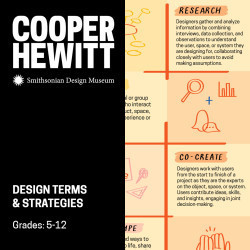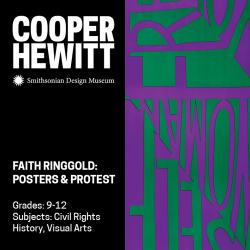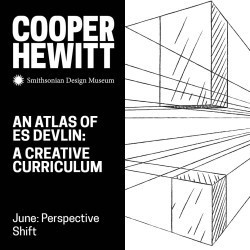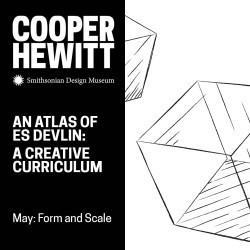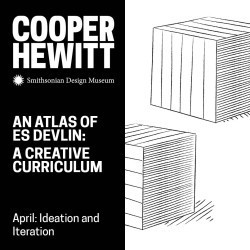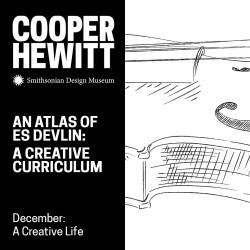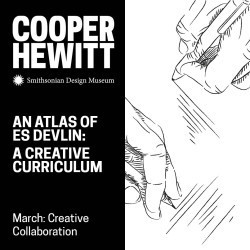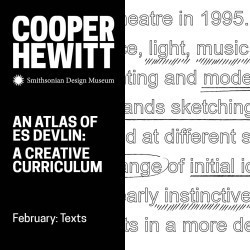Cooper Hewitt Education Department's collections
Design Terms & Strategies
<p>Grades: 5-12</p>
<p><a href="https://www.cooperhewitt.org/wp-content/uploads/2024/12/Design-Terms-Strategies.pdf" target="_blank">View the pdf here</a></p>
<p>A simple one-page reference sheet of design terms and strategies.</p>
 Cooper Hewitt Education Department
Cooper Hewitt Education Department
2
Faith Ringgold: Posters & Protest
<p>Link to activity lesson: <a href="https://docs.google.com/presentation/d/1WtC8Ib_fxiRR7-CstP2CiScGIDUHF5aw5OeAZiHYd1M/edit#slide=id.p">https://docs.google.com/presen...</a></p>
<p>Analyze political posters designed by artist, author, and activist Faith Ringgold, and design your own protest poster about a civil rights issue today.</p>
<p>Grades:9-12</p>
<p>Subjects: Civil Rights History, Visual Arts</p>
 Cooper Hewitt Education Department
Cooper Hewitt Education Department
1
July: Participation
<p><a href="https://www.cooperhewitt.org/july-participation/">JULY: PARTICIPATION</a></p>
<p><strong>Age: Middle School, Highschool</strong></p>
<p>In her public installations, Es Devlin often transforms audiences from viewers to participants, inviting us to become protagonists in a work. To achieve this, she might present audiences with a short film projected onto a screen that splits apart. Upon passing through the screen, we enter an unfolding narrative as a participant. Devlin might also invite audiences to navigate a mirrored maze, or she might harness the power of collective poetry, asking us to donate words to artificial intelligence algorithms that generate poems in public spaces. For Devlin, participation becomes a transformative act that deepens our encounter with an idea. </p>
<p>We engage with participation by asking our audiences to actively take part in a work. By directly engaging with a concept, we strengthen its connection with other lived experiences in our minds. Participation might also materialize in our creative practices as we become more mindful of our encounters and actions in the world around us, transforming our connections to one another and our planet. The materials on this page invite you to explore participation in your creative practice. You will find examples of what participation looks like in the work of others, as well as prompts and exercises that encourage your own participation by consciously connecting with your daily life and community. </p>
 Cooper Hewitt Education Department
Cooper Hewitt Education Department
2
December: A Creative Life
<p><a href="https://www.cooperhewitt.org/december-a-creative-life/">DECEMBER: A CREATIVE LIFE | Cooper Hewitt, Smithsonian Design Museum</a></p>
<p>Devlin’s creative life began in childhood. Like many of us, she made things to entertain herself. She built dioramas and staged plays with her siblings, holding candy wrappers against a projector’s light in order to wash the room in different colors. She both studied and created art. An avid reader, she loved to mark in her books. She also learned to play the piano, violin, and clarinet. During visits to museums, she explored exhibitions that introduced her to new types of sculpture and installation, some of which inspired her artwork for many years to come. Over 30 years, she’s expanded and adapted her craft while nurturing a thriving studio space.</p>
<p>While Devlin models one version of an artistic life, all of us make creative choices every day. Our favorite movies, meals, books, and music reflect how we see ourselves and the world around us. Even the ways we build relationships and share experiences reflect our creativity. Connecting with our creativity sometimes requires us to change our routines in order to open new space for reflection or action. The prompts, exercises, and programs on this page provide some ways to spark and develop creative thinking.<br><br></p>
 Cooper Hewitt Education Department
Cooper Hewitt Education Department
2
March: Creative Collaboration
<p><a href="https://www.cooperhewitt.org/march-creative-collaboration/"></a><a href="https://www.cooperhewitt.org/march-creative-collaboration/">MARCH: CREATIVE COLLABORATION | Cooper Hewitt, Smithsonian Design Museum</a><a href="https://www.cooperhewitt.org/march-creative-collaboration/"></a></p>
<p><strong>Age: Middle School, Highschool</strong> </p>
<p>Collaboration is essential to Es Devlin’s artistic practice. Directors, studio associates, lighting designers, production managers, musicians, video designers, writers, fabricators, and more enrich her work and make it possible at such a grand scale. Some collaborations might last a few months while others endure for many years. All of them unfold over a continued conversation. No one person always has the best idea, and exchanging ideas fosters stronger outcomes. </p>
<p>While Devlin’s collaborations often have an end goal, much of the richness of working with others comes from the places you explore together along the way—the dead ends, the abandoned ideas, the miscommunications, the fresh starts. Working with someone offers a chance to consider new ways of thinking, and that exchange can inspire new directions for creative work. The exercises and materials on this page offer some ways to kickstart or reflect on collaboration in your own life. What might you learn from one collaboration that you apply to the next? </p>
 Cooper Hewitt Education Department
Cooper Hewitt Education Department
2
February: Texts
<p><a href="https://www.cooperhewitt.org/february-texts/">FEBRUARY: TEXTS | Cooper Hewitt, Smithsonian Design Museum</a></p>
<p><strong>Age: Middle School, High school </strong></p>
<p>The act of reading is central to Es Devlin’s process for translating plays, operas, or song lyrics to stage designs or stadium tours. While reading, she underlines important passages and makes sketches in the margins of books. She returns to these notes as she considers the form of a stage sculpture or the narrative journey through an installation. </p>
<p>Reading provides us an opportunity to immerse ourselves in someone else’s thoughts. We imagine a world built by their words. On its own, reading can expand our thinking and open us to new understanding. But texts can also help spark our own creative ideas. The materials on this page encourage you to explore new ways to engage with texts as part of a creative practice. </p>
 Cooper Hewitt Education Department
Cooper Hewitt Education Department
2

